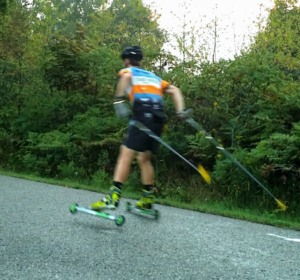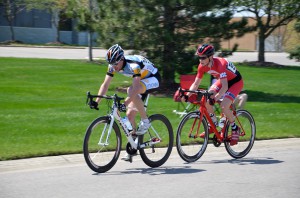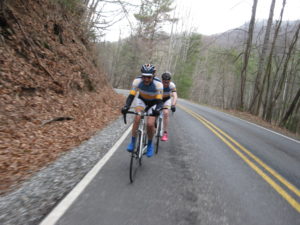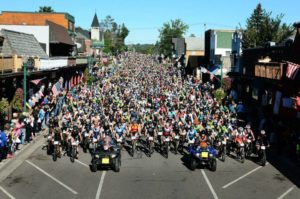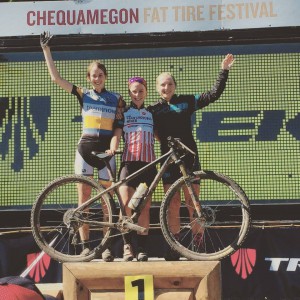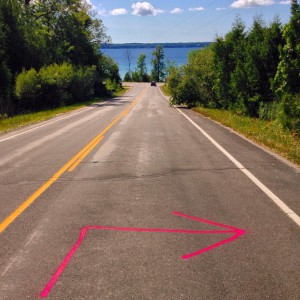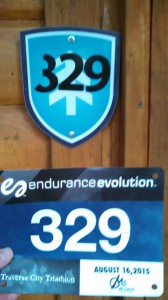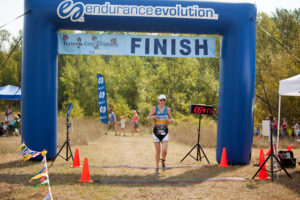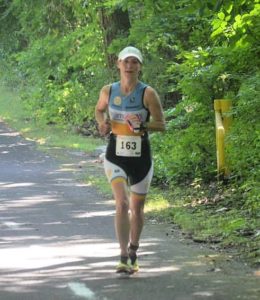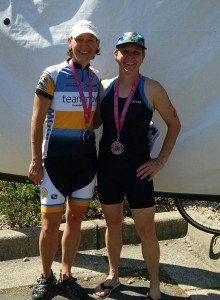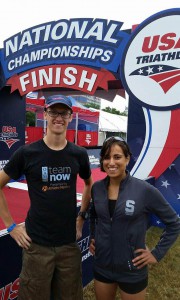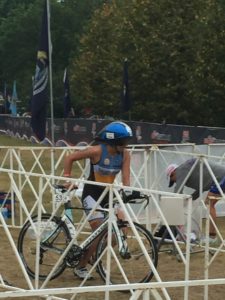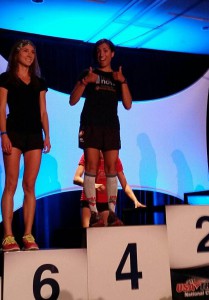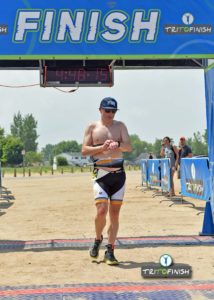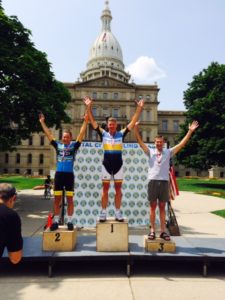By Elaine Sheikh, Team OAM Now Triathlete
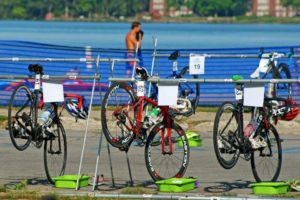 Triathlon is a sport dominated by “Type A” individuals. As a whole, we are very precise people. We can spout off our 500 time for yards and meters; we can give you not only our 5K and 10K PRs, but those of our friends and competitors, VO2 max on the bike, and max heartrates for our individual sports without stopping to think. We are extremely particular about our item placement in transition. We have our ritualistic pre-race dinners and breakfasts. We like to have plans and be prepared, but ultimately, external factors greatly affect the outcome of a race. It can be 40 degrees and raining at a triathlon in June, then 95 degrees and humid at one in July. There are circumstances you just can’t prepare for. In every race, something will not go according to plan. Triathlon is a sport that requires adaptation to succeed.
Triathlon is a sport dominated by “Type A” individuals. As a whole, we are very precise people. We can spout off our 500 time for yards and meters; we can give you not only our 5K and 10K PRs, but those of our friends and competitors, VO2 max on the bike, and max heartrates for our individual sports without stopping to think. We are extremely particular about our item placement in transition. We have our ritualistic pre-race dinners and breakfasts. We like to have plans and be prepared, but ultimately, external factors greatly affect the outcome of a race. It can be 40 degrees and raining at a triathlon in June, then 95 degrees and humid at one in July. There are circumstances you just can’t prepare for. In every race, something will not go according to plan. Triathlon is a sport that requires adaptation to succeed.
I was toeing the start line at the Detroit Tri U25 EDR one week after a successful weekend at USAT Nationals. It was to be my first draft legal race, and I was excited to compete in such a strong field of women. The top three finishers would receive pro cards that day. I fully anticipated finishing towards the back of the pack, but all I really wanted was to race hard and well enough to avoid being lapped out. In draft legal races, the bike leg takes place on a multi-loop course and if you are passed by the race leaders, you are to dismount your bike and make your way back to transition. You are not allowed to finish the race.
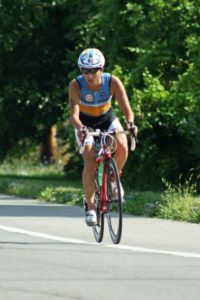 The swim was non-wetsuit, but I was not the last person out of the water, despite being pretty far off the back of the pack. On the bike, I quickly caught one woman, but she was unable to hold my wheel, so I lost hope of being able to work with her. I worked as hard as I could on the bike, and knew that I was not in danger of being lapped. When I went to dismount my bike, however, I realized I was incredibly dizzy. I nearly tripped as I dismounted, but caught myself with my bike. I headed out on the run course, but disaster struck immediately. My breathing was completely out of control and my vision was foggy. My chest was tight and I knew I was hyperventilating. I have hyperventilated in races before and knew that if I could slow down and get some deep breaths, I would probably be okay. This time though, my dizziness and the darkness rushing in from the edges of my field of vision caused me to stop completely.
The swim was non-wetsuit, but I was not the last person out of the water, despite being pretty far off the back of the pack. On the bike, I quickly caught one woman, but she was unable to hold my wheel, so I lost hope of being able to work with her. I worked as hard as I could on the bike, and knew that I was not in danger of being lapped. When I went to dismount my bike, however, I realized I was incredibly dizzy. I nearly tripped as I dismounted, but caught myself with my bike. I headed out on the run course, but disaster struck immediately. My breathing was completely out of control and my vision was foggy. My chest was tight and I knew I was hyperventilating. I have hyperventilated in races before and knew that if I could slow down and get some deep breaths, I would probably be okay. This time though, my dizziness and the darkness rushing in from the edges of my field of vision caused me to stop completely.
I remember sitting down on the side of the course (and, like a true data addict, somehow I stopped my watch as well). Then a volunteer was screaming and the next thing I knew I was on my back with a bunch of people standing over me shoving ice in my tri suit. I started gagging and they rolled me on my side. I couldn’t open my eyes and my breathing was still out of control. As soon as I could talk, I started begging to finish my race. The medics would have none of it, though. I hadn’t been lapped out. My body just gave out.
I had never had a DNF in a triathlon before that day. A DNF was not part of my plan. Although I frequently doubt the quality of my performance, I never doubt that I will finish a race. Sometimes, though, it isn’t up to you. So, what do you do in a situation like that? Well, I for one will try again. Sure, my confidence is shaken. No one likes their race to be out of their control, but I plan to race again this weekend. And the thought of a DNF will not cross my mind.
I will not doubt my ability to finish. I cannot allow myself to do so. Triathletes are not just Type A people. They are strong. They are resilient. They can endure. And they never give up.
The post After Success Comes Setback, After Setback Comes Resilience and Strength appeared first on Team Athletic Mentors.
 As I often explain to my roadie counterparts, cyclocross isn’t so much a discipline of cycling as it is a mindset. The mindset of a ‘cross racer is one of excitement and adventure. One where your response to your buddies half-joking proposal of a ludicrously difficult ride is a full-hearted, “Lets do it!”. One where every race morning is greeted by the giddy excitement of a child about to open his presents on Christmas morning. As the ‘cross season is just around the corner, there is a collective sense of excitement amassing among us mud-junkies as we await the first race of the season. The tires have been glued, the bikes have been built, and our skills honed during the off-season. Now, all we need is for the starter to blow his whistle and we’re off.
As a ‘cross racer, I love to ride my bike, whether it is during a race, a fun training ride, or even a set of hill repeats. My coach would probably tell you I love riding a little bit too much. During a recent week-long trip to Colorado, I almost couldn’t be contained. On my first day there, I had the chance to ride my cyclocross bike at Valmont Bike Park, site of the 2014 Cyclocross National Championships. With a dedicated sandpit, two sets of dedicated stair dismounts, and lots of flowy singletrack, this was by far the coolest course I had ever ridden. There was even a pump track (although I doubt it was intended for cyclocross bikes)! Before the trip, my coach had told me to just take it easy and do 60 minutes of Z1/2 in order to acclimatize. While I managed to keep my effort level contained, I couldn’t help myself and rode for over 100 minutes. Over the course of the next 5 days, I rode my MTB for about 3 hours a day in Durango and Gunnison and somehow managed to contain my ride time and efforts despite my overflowing excitement.
As I often explain to my roadie counterparts, cyclocross isn’t so much a discipline of cycling as it is a mindset. The mindset of a ‘cross racer is one of excitement and adventure. One where your response to your buddies half-joking proposal of a ludicrously difficult ride is a full-hearted, “Lets do it!”. One where every race morning is greeted by the giddy excitement of a child about to open his presents on Christmas morning. As the ‘cross season is just around the corner, there is a collective sense of excitement amassing among us mud-junkies as we await the first race of the season. The tires have been glued, the bikes have been built, and our skills honed during the off-season. Now, all we need is for the starter to blow his whistle and we’re off.
As a ‘cross racer, I love to ride my bike, whether it is during a race, a fun training ride, or even a set of hill repeats. My coach would probably tell you I love riding a little bit too much. During a recent week-long trip to Colorado, I almost couldn’t be contained. On my first day there, I had the chance to ride my cyclocross bike at Valmont Bike Park, site of the 2014 Cyclocross National Championships. With a dedicated sandpit, two sets of dedicated stair dismounts, and lots of flowy singletrack, this was by far the coolest course I had ever ridden. There was even a pump track (although I doubt it was intended for cyclocross bikes)! Before the trip, my coach had told me to just take it easy and do 60 minutes of Z1/2 in order to acclimatize. While I managed to keep my effort level contained, I couldn’t help myself and rode for over 100 minutes. Over the course of the next 5 days, I rode my MTB for about 3 hours a day in Durango and Gunnison and somehow managed to contain my ride time and efforts despite my overflowing excitement.
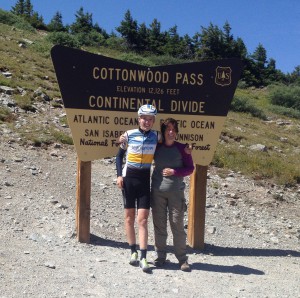 As the last day approached, my excitement overtook me and my planned 2-hour training ride went out the window. Starting in Buena Vista, I rode up the paved side of Cottonwood Pass, a 20 mile climb at 5% average with several sections approaching 12%. I made it to the top, put on some gloves and a vest for the descent down the other side, ate the breakfast burrito stashed in my back pocket, and I was off! The descent down the backside is a 15-mile dirt road descent strewn with deep ruts, washboards big enough to be confused for a pump track, and loose rocks the size of a small melon. On a cantilever ‘cross bike, there wasn‘t much I could do in terms of slowing down, so I let it rip. Once I got to the bottom, I turned around and went straight back up!
As the last day approached, my excitement overtook me and my planned 2-hour training ride went out the window. Starting in Buena Vista, I rode up the paved side of Cottonwood Pass, a 20 mile climb at 5% average with several sections approaching 12%. I made it to the top, put on some gloves and a vest for the descent down the other side, ate the breakfast burrito stashed in my back pocket, and I was off! The descent down the backside is a 15-mile dirt road descent strewn with deep ruts, washboards big enough to be confused for a pump track, and loose rocks the size of a small melon. On a cantilever ‘cross bike, there wasn‘t much I could do in terms of slowing down, so I let it rip. Once I got to the bottom, I turned around and went straight back up!
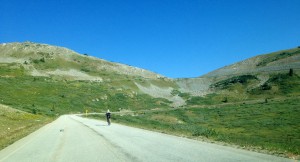 I couldn’t help but be in awe of where I was as I rose towards 14, 000 ft. peaks and looked down onto a sparkling reservoir below me. As I crested the 12,000 ft. pass, I knew my climbing was behind me, and I let it rip down the pavement descent. Nothing feels better than passing a 35 mph speed limit sign while screaming down the mountain at 55 mph on 25c tires. After the ride, I texted my coach and told him that if we halved my ride time and rounded down, I had done the workout to perfection. At least I stayed in the right zones!
As I prep for ‘cross season, my coach had me do a hard week full of intervals and FTP efforts. At the end of the week, a rare and beautiful ride description was entered into Sunday’s Column: Choice Ride! I was so excited I couldn’t contain myself. I immediately messaged my buddy Jesse, asking if he wanted to ride the 62-mile Barry Roubaix route. It was a mere formality, as he is always game for just about anything. This is the same guy I can always count on to show up to group rides in 50 degree rain and agree to do the long route. He is even crazy enough to travel all over the midwest with me this year racing a full cyclocross calendar.
As we embarked on the route neither of us had ever done before, one of the first things out of Jesse’s mouth was, “Wanna do a lap on the ‘cross bikes at Yankee when we finish?” As the ride panned out, I was feeling good, so I decided to go for it. Unfortunately, we got a little lost on the 62-mile route as neither of us had ever done it before, but that didn’t deter us from doing 15 miles of Yankee Springs on the 33c tires afterwards.
Although we might look crazy, covered head-to-toe in mud, with wild fans screaming at us from the sidelines, cyclocross racers certainly love to ride their bikes. I think not only is ‘cross fun for the type of courses it provides, but also for the atmosphere it caters to, as many of the riders simply love to be on their bikes. So, if you want to really become a ‘cross racer this year, ride every race for the fun of it, and ride every training ride for the adventure that you will get. And if you see me out racing this year, don’t forget to heckle me!
The post Team OAM Now’s Tristan Visits Colorado to Prep for Cyclocross Season appeared first on Team Athletic Mentors.
I couldn’t help but be in awe of where I was as I rose towards 14, 000 ft. peaks and looked down onto a sparkling reservoir below me. As I crested the 12,000 ft. pass, I knew my climbing was behind me, and I let it rip down the pavement descent. Nothing feels better than passing a 35 mph speed limit sign while screaming down the mountain at 55 mph on 25c tires. After the ride, I texted my coach and told him that if we halved my ride time and rounded down, I had done the workout to perfection. At least I stayed in the right zones!
As I prep for ‘cross season, my coach had me do a hard week full of intervals and FTP efforts. At the end of the week, a rare and beautiful ride description was entered into Sunday’s Column: Choice Ride! I was so excited I couldn’t contain myself. I immediately messaged my buddy Jesse, asking if he wanted to ride the 62-mile Barry Roubaix route. It was a mere formality, as he is always game for just about anything. This is the same guy I can always count on to show up to group rides in 50 degree rain and agree to do the long route. He is even crazy enough to travel all over the midwest with me this year racing a full cyclocross calendar.
As we embarked on the route neither of us had ever done before, one of the first things out of Jesse’s mouth was, “Wanna do a lap on the ‘cross bikes at Yankee when we finish?” As the ride panned out, I was feeling good, so I decided to go for it. Unfortunately, we got a little lost on the 62-mile route as neither of us had ever done it before, but that didn’t deter us from doing 15 miles of Yankee Springs on the 33c tires afterwards.
Although we might look crazy, covered head-to-toe in mud, with wild fans screaming at us from the sidelines, cyclocross racers certainly love to ride their bikes. I think not only is ‘cross fun for the type of courses it provides, but also for the atmosphere it caters to, as many of the riders simply love to be on their bikes. So, if you want to really become a ‘cross racer this year, ride every race for the fun of it, and ride every training ride for the adventure that you will get. And if you see me out racing this year, don’t forget to heckle me!
The post Team OAM Now’s Tristan Visits Colorado to Prep for Cyclocross Season appeared first on Team Athletic Mentors. 



 Our Hockey Site
Our Hockey Site Team AM
Team AM


